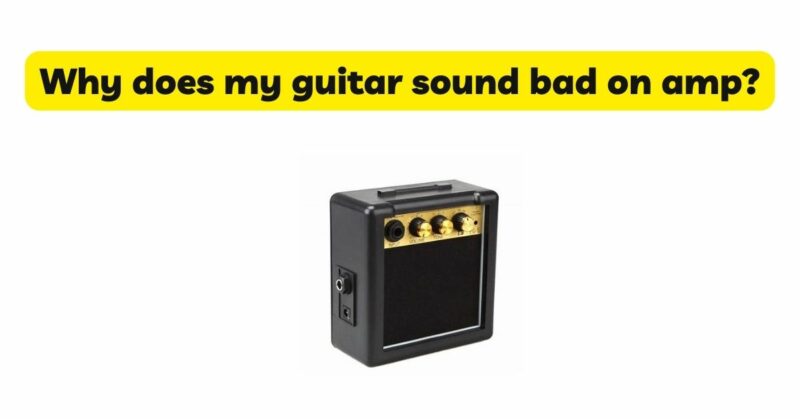As a guitarist, discovering that your instrument sounds subpar when connected to an amplifier can be disheartening. Several factors can contribute to a guitar sounding bad on an amp, ranging from technical issues to improper settings and playing techniques. In this article, we will explore common reasons why a guitar may sound unsatisfactory when plugged into an amplifier. By understanding these factors, you can troubleshoot and address the issues, improving the overall sound quality and ensuring a more enjoyable playing experience.
- Technical Issues: a. Faulty Cables: The quality of cables connecting the guitar to the amp can impact the sound. Damaged or low-quality cables may introduce interference, signal loss, or poor connectivity, resulting in a degraded sound quality. b. Input Jack Problems: Loose or malfunctioning input jacks can cause intermittent connections, leading to crackling sounds, dropouts, or reduced volume. c. Pickup Issues: Malfunctioning or improperly adjusted pickups can affect the guitar’s output, resulting in a weak or uneven signal. Check the pickups for any loose connections or consult a technician for adjustments or repairs.
- Incorrect Amp Settings: a. EQ and Tone Controls: Improperly adjusted EQ and tone controls on the amp can negatively impact the guitar’s sound. Experiment with the bass, mid, and treble settings to find a balanced tonal response and compensate for any tonal deficiencies. b. Gain and Volume Levels: Incorrect gain and volume settings can lead to distortion, excessive noise, or a lack of clarity. Adjust the gain and volume controls to achieve a desirable balance between clean and overdriven tones.
- Room Acoustics: a. Reflections and Resonance: Poor room acoustics, characterized by excessive reflections and resonances, can affect the sound of the guitar on an amp. Consider adding acoustic treatment, such as diffusers or absorbers, to minimize unwanted reflections and improve clarity. b. Standing Waves: Standing waves caused by room dimensions can create frequency build-ups or cancellations, resulting in an uneven frequency response. Adjust the placement of the amp and guitar within the room to mitigate the impact of standing waves.
- Guitar Setup and Maintenance: a. Action and Intonation: Poorly set up guitars with high action or incorrect intonation can affect the playability and sound quality. Consult a professional guitar technician to ensure proper setup and adjustment, optimizing the instrument’s tonal performance. b. Strings: Old or worn-out strings can produce a dull, lifeless sound. Regularly change your strings to maintain freshness and improve the tonal clarity and brightness of the guitar.
- Playing Technique and Articulation: a. Fretting Technique: Inaccurate finger placement or insufficient finger pressure on the frets can cause notes to sound out of tune or muted. Practice proper fretting technique to ensure clear and accurate note production. b. Picking Technique: Improper picking technique, such as excessive force or incorrect angle, can result in unwanted string noise, uneven dynamics, or a harsh tone. Focus on developing a controlled and consistent picking technique to improve the overall sound quality.
- Amplifier Quality and Matching: a. Mismatched Amp and Guitar: Using an amp that is not well-suited to the guitar’s pickups, tonal characteristics, or playing style can result in an unbalanced or unpleasant sound. Consider matching the guitar’s tonal requirements and playing style with an appropriate amplifier. b. Low-Quality Amp Components: Poor-quality amplifiers may have subpar components that adversely affect the sound quality. Upgrading to a higher-quality amp with reliable components can significantly improve the overall tone and performance.
- Pedal Interactions: a. Effects Pedals: The placement and order of effects pedals in the signal chain can impact the guitar’s sound. Experiment with different pedal configurations to find the optimal order and balance between the guitar, pedals, and the amp.
Conclusion: When a guitar sounds bad on an amp, it can be a frustrating experience for any guitarist. By identifying and addressing potential issues such as technical problems, incorrect amp settings, room acoustics, guitar setup and maintenance, playing technique, amplifier quality, and pedal interactions, you can improve the sound quality and unlock the full potential of your instrument. Remember to regularly maintain your gear, experiment with different settings and techniques, and seek professional assistance when needed. With diligence and attention to detail, you can achieve a satisfying and inspiring sound when playing your guitar through an amplifier.


